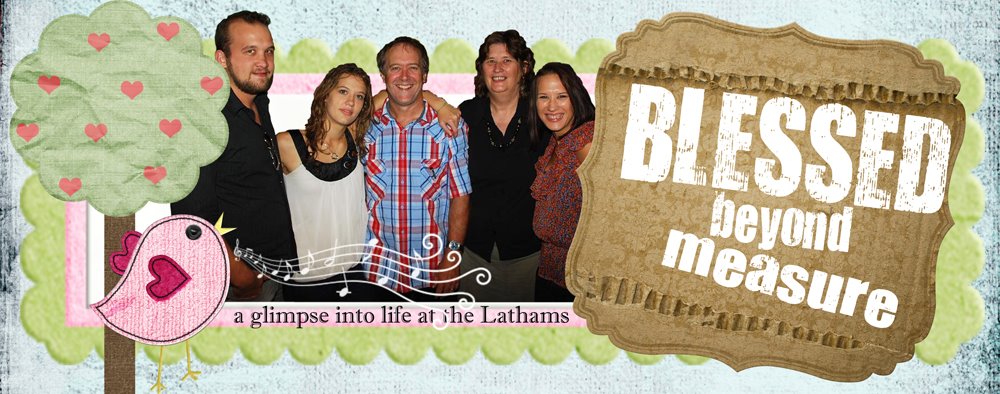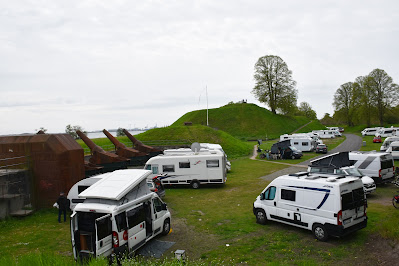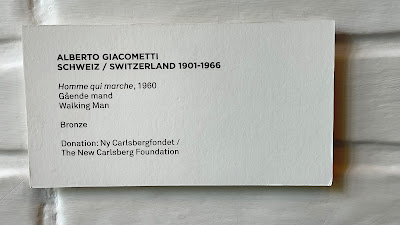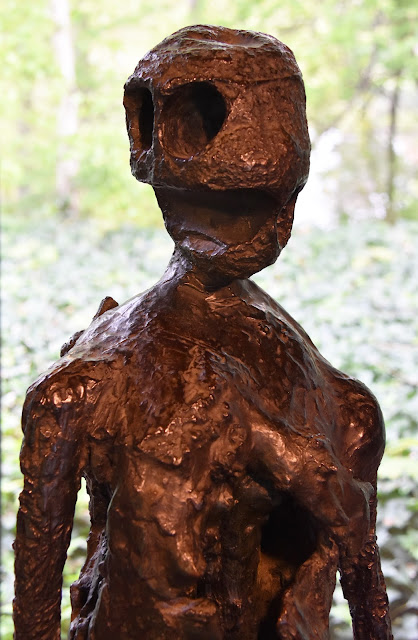DAY 18 - CHARLOTTENLUND FORT AND LOUSIANNA GALLERY OF MODERN ART… Wedneday 11th May, 2022
Yesterday we had planned on visiting both Kronborg Castle and the Lousianna Gallery of Modern Art, but we had no idea just how fabulous Kronborg Castle was really going to be and we ended up spending all day there...
I was still really keen to visit the Lousianna Gallery of Modern Art. We had driven up there the last time we were in Denmark, but hadn't arrived until mid afternoon so figured it wasn't worth paying the admission charge that time and we would leave exploring it to our next visit. I am so pleased we did, as we drove up there in Winter last time, whereas this visit we came in Spring and the gardens were just stunning..
Peter suggested that we take the coastal road up to the Gallery and to stop off and check out Charlottenlund Fort on the way. Today Charlottenlund Fort isn't just an old military fort. It is now a exciting and beautiful caravan park with a popular swimming beach and bathhouse. It lie between Charlottenlund Forest and the its open green spaces provide the setting for a host of leisure activities.
 |
| Entrance to Charlottenlund Fort |
The fort was built below Charlottenlund Palace as part of the fortifications around Copenhagen in the years 1886-88. The fort was part of the series of sea fort that had to protect Copenhagen from the lake side and was part of the middle line of forts together with the Middlegrundsfort and Kastrup Fort.
It was originally a coastal battery, but in a 1910-12 it was converted to a coastal fort. The fort is enclosed by a moat, there is a large mound in the centre where the main part of the fort is and there are 8 battery guns, 4 on either side of the central mound of the fort. The fort was modernised as part of Denmark's seaside defenses.
As we were checking out the big cannon we met a local who was telling us about these huge machines. The government spent millions of dollars on these cannons and they had never been fired, with the esception of one. A few years ago, a million dollars was spent on restoring the green gun and it was fired once to see if it would actually work. Since then, no more money has been spent on it, and no money has been spent on any of the other guns. Rather a huge waste of money...
 |
| Over a million dollars was spent on restoring this gun. |
We climbed up the embarkment that surrounds the fort and found a lovely little restaurant there that overlooked the ocean. There were also walking tracks between the fort and the beach what seemed to be quite popular with locals either walking the path or exercising.
 |
| Lovely restaurant overlooking the sea... |
 |
| A bridge over the moat connects the fort to the beach... |
 |
| There is a moat around the fort.. |
There is lovely parklands outside the fort which are dominated by large, open graefaelleder with single tree and small garden spaces framed by close cropped hedges and it appeared to be a popular picnic spot.
The beach is a very popular swimming spot in Summer. It seemed popular today also as we saw quite a few people coming and taking a dip in the ocean.. In fact Danish beaches are unlike Australian beaches. It is not uncommon to see folk come down to the beach and strip right off and head into the water, unlike our beaches though they do not last very long in the water with their dips lasting for only a few mintues before they hop out, towel off, get redressed into their clothes and coats etc and head off to continue their day.
To us, the effort seems hardly worth it for such a short time in the water. Also, the water up here is FREEZING cold. At home we would need to be able to remain in the water for at least half an hour or more to make it even worthwhile hoping into the water..
The fort was beautiful and green with lots of Spring wildflowers grow wild everywhere. This is one of the things I love about Denmark, the beautiful wild flower, and even the weed are beautiful..
We walked along the upper inner ridge of the fort, taking in the views of all the caravans below. It was quite a popular park. There seemed to be more RV's than caravans at the park and the caravans that were there, were very different to the caravans in Australia. You do not see big caravans in Denmark. Most wouldn't be any more than 17ft long. In fact that would be a very long van.
This might also have something to do with the fact that Danes do not drive big cars. Cars are very expensive in Denmark as is fuel.
 |
| Stairs leading up to the observation hill in the middle of the fort |
 |
| An aerial shot of Charlottenlund Fort... |
There were a lot of campers there when we were there, so it appears to be a pretty popular camp grounds.
From checking out all the vans and camp sites, we made our way up the mound in the centre to check out the battery...
At the defense settlement of 1909, money was allocated for a modernization of the battery, and it was converted into Charlottenlund Fort in the years 1910-12.
A casemate building with an engine room and 7 rooms for the crew was built in connection with the 5 existing ammunition magazines in the large traverse.Towards the lake, the equipment was changed so that 2 pieces of 120 mm were set up on concrete slabs to the south of the large traverse. guns and 4 pcs. 29 cm. howitzers in a battery.
To-day the guns are gone from the battery and the the buildings are deserted and in ruins on the large traverse but it was interesting to walk through and around these ruins.
During the 1st World War, further pads were cast for 2 x 17 cm. cannons on the great traverse. However, these were never placed. A brisket was also cast for, and mounted, a 47 mm. balloon cannon on the large traverse. The fort was additionally provided with 2 x 150 cm. searchlights, 1 in an elevator in well immediately north of the large traverse and 1 on a rail track at the foot of the parapet.
 |
| Prepared for a cannon that was never placed. |
After checking out the military side of the fort, we then spent some time on the mound enjoying the wonderful 360 degree views of the fort itself along with the beach and forest.
 |
| Wonderful views of the coastline. |
 |
| Very popular parkland with many people out enjoying the Spring weather |
We didn't see a lot of small motor craft in Denmark, not like the aluminum tinnies we have back home, but we often saw people out rowing in wooden boats. Most of the boats we saw in Denmark were quite a good size, and not just recreational fishing boats.
 |
| Birds eye view of the caravan park below.. |
Once down off the mound we continued to walk around the park checking out the different rigs they have over here. RV's like these work well in Denmark. Most carry bikes with them and use their bikes then to get around and explore. This is pretty easy to do over here, as they have bike ways throughout the country and Danes love to ride. In fact in Copenhagen itself, there are thousands of bikes. Everyone rides. You need to be careful when driving in the capital and even crossing the roads as bikes get right of way.
 |
| Steps up and down the centre fort mound... |
The dandelions are prolific everywhere over here at the moment. I cannot get over the hugeness of them. They are massive. We don't get them back home anywhere near as big as they grown over here. I love them, they are so pretty.
 |
| Such a cute little set up... |
As we came back to the entrance to the park, we came across the amenities block.. These are located in the old armoury and have been newly rebuilt. Appartently they are well maintained and have 4 showers each for men and woman along with washbasins and loos. They are operated by a keycard for the hot water. They also have an inside kitchen with a number of gas cookers, microwave and worktop spaces along with sinks. They have internal tables to eat at as well as a lounge area to relax in. There is also a laundry with machines and dryers.
Unfortunately there is no playground, but it's location to the beach is a place for families and the mound in the centre also allows for entertainment for children.
The other bonus is that it is only about a 15 minute ride into the centre of Copenhagen.
 |
| The amenities have been built in the old armoury... |
 |
| Camp Kitchen also built into the old armoury... |
We spent a good hour exploring the fort and as we headed back to the car we took in some of the bird life. We were so pleased that Pete suggested that we stop off and check out Charlottenlund as we really enjoyed our visit and it was probably something we would never have visited without his prompting. We have visited Kastrup Fort in Copenhagen on our first visit in 2016 and now Charlottenlund. Maybe our next visit we will have to check out Middlegrundsfort.
 |
| Different bird are found over here also.. |
 |
| We found some black faced seagulls in Denmark... |
As much as we have enjoyed our visit to Charlottenlund Fort, it was time to head off to our planned destination for the day. We are off to check out the Lousiana Gallery of Modern Art which is located in Humlebæk.
The drive there this time was slightly different to the drive we took up here in 2018. We drove up in Winter last time,and the trees through this part of the forest were just bare sticks. This time we drove through a canopy of lush green trees and it was beautiful.
Half an hour north of Copenhagen in the sleepy coastal village of
Humlebæk, lies one of the world’s most respected and sensational art
experiences the Louisiana Museum of Modern Art, a groundbreaking institution set inside a major work of Danish modernist architecture. It was establihed in 1958 and expanded several times until the building reached it current shape in 1991.
What makes the Louisiana so unique however is not only its world-class art collection, but the unassuming setting in which the works are presented. An 1870s villa, surrounded by three modernist pavilions, is connected by glass-walled passages set amidst a sprawling sculpture park at the edge of the Øresund, called the Sound in English; a strait which looks out to southern Sweden.
 |
|
“Reclining Figure” by Henry Moore 1969-1970. |
It is well worth the visit to the Louisiana Gallery of Modern Art. We loved it and spent the rest of the day there and still didn't manage to see it all. It is the sort of place you could visit time and time again and each time see something different. The grounds and the scenery are absolutely stunning and it is so peaceful and relaxing there.
There is quite a story to the Museum. Louisiana's founder, Knud W. Jensen, wanted to create a museum where Danes could see modern art, which until then had no special place in the Danish museums.
In the mid-50s, when the museum’s founder Knud W. Jensen asked the architects Jørgen Bo and Wilhelm Wohlert to build a museum based on the old villa, their foundational plan was to link the building with its sea surroundings. For this reason, it is such a memorable gallery, blending indoor and outdoor together so seamlessly, providing an all-encompassing scenic experience for regulars and tourists alike.Ticketing to the Gallery is at the shop front, so it was the first place we stepped into. They had some amazing pieces for sale all at amazing prices, so we just enjoyed having a good look. Steve headed downstairs to the toilet and appartently there were more delights down there as well as a section for children.
From the beginning, the founder, Knud W. Jensen, intended for the museum to be a home for modern Danish art. But after only a few years he changed course, and instead of being a predominantly Danish collection, Louisiana became an international museum with many internationally renowned works.
From the beginning, it was Knud W. Jensen’s vision to create a museum with soul, where the public could encounter artwork – not as something pretentious, but rather something that spoke directly to the viewer. And he emphasized the need for “supplementary content” that could help bring alive and enrich the environment: |
|
“Uden title” (Untitled) by Willy Ørskov 1972. |
 |
|
“Three Piece Reclining Figure: Draped” by Henry Moore 1974-1975. |
 |
|
“Grande Femme debout à la draperie” by Henri Laurens 1928. |
 |
| The original country house.. |
 |
|
“Vénus de Meudon” by Jean Arp 1956. |
 |
|
“Human Concretion on an Oval Bowl” by Jean Arp 1948. |
 |
|
“Coupes superposées” (Stacked Bowls) by Jean Arp 1947. |
 |
| Alicja Kwade's stone globes |
 |
|
“Pars Pro Toto” by Alicia Kwade 2018. |
One of the things we loved about the Sculpture Park was that the sculptures were not imposing on the beauty of the gardens. Set against the shores of the Øresund Sound (the sea dividing Denmark from Sweden), set amongst the huge trees and blending with nature. The sculptures are positioned so that they interact
with the architecture and nature surrounding them. An example of this is Henry Moore’s sculpture Reclining Figure No. 5 (Seagram), which stands out
by the cliff with the Sound as a living backdrop.
Similar examples are the so-called site-specific sculptures, including Richard
Serra’s The Gate in the Gorge and George Trakas’ Self Passage, which were
acquired for their specific placements, where they become a very concrete part
of the terrain.
 |
|
“Seuil-réflexion” (Reflection) by Jean Arp 1960-1982. |
 | |
|
 |
|
“Nervures minces” by Alexander Calder 1963 |
 |
|
“Almost Snow Plough” by Alexander Calder 1976 |
 |
| Amazing views of the Sound... |
We spent the morning enjoying the sculpture park, wandering around and checking out the sculptures and the views, until we started to get hungry. We were informed that there was a cafe on sight so went in search of it as we figured we would sit down and enjoy some lunch. The cafe was quite big with inside and outside seating. As it was still quite cold and damp outside with rain drizzling, we opted for a table indoors. The place was quite busy but we noticed that it was attached to one of the galleries so decided to have a look inside there whilst we waited for the crowds to thin out so that we could get an indoor table...
We thought the outdoors were really good, but the indoor galleries were amazing... Wandering through the gallery attached to the shop we had plenty to explore.. This part of the museum housed some of their feature galleries which were definitely worth viewing..
Louisiana also has a special children's museum called Louisiana Børnehus which we came across. This three story Children's Wing offers open worksops every day where children from 4 to 16 can paint, draw, sculp and explore artists' and architects' working methods and expressions. We thought this was pretty good.
 |
|
“Le grand pouce” (The Large Thumb) by César 1968 |
 |
|
“Manoir d'Essor” by Jean Dubuffet 1969/1982 |
These highlights of the museum have each in their very different way earned a very special status and reputation & should not be missed during your visit to Louisiana.
 | |
|
 |
|
“Udkast til "Offerscene"” (Study for "Scene of Sacrifice" ) by Richard Mortensen 1945. |
One of Louisiana's special gallery is for the works of Asger Jorn who is one of the most recognised 20th century painters from Denmark. He was an artist best known for his paintings, lithographs and etchings. Through his work he experimented with the spontaneity of the line and semi-figerative representations...
 | |
|
 |
|
“L'Ouragane” (Hurricane) by Germaine Richier 1948-1949 |
 | |
|
 |
|
“Siddende kvinde” (Seated Woman) by Svend Wiig Hansen 1964. |
 | |
|
One of the things I loved about this museum is their discrete pavilions and their semi transparent glass corridors which brings the outdoors in as if it is all part of the building, All the art works blend in perfectly to create visually connected spaces. It was truly magnificent..
 |
|
“La Tauromachie” (Bull Fight) by Germaine Richier 1953. |
The Gallery at Louisiana is dedicated to his later works of the tall and slender figurines. We were fortunate enough to view this Gallery whilst the the museum's director Poul Erik Tøjner was doing a guided tour through the gallery.
 |
| This gallery had amazing views out to the Lower garden.. |
 |
| “Homme
qui marche” (Walking Man) by Alberto Giacometti
1960. |
 |
| “Buste d'Annette IV” (Bust of Annette IV) by Alberto Giacimetti 1962. |
 | |
|
 |
|
“La Sauterelle” (Grasshopper) by Germaine Richier 1956. |
Steve was very interested in the Palle Nielsen drawing. They were quite detailed and he enjoyed reading all his notes. We had never heard of Palle Nielsen before our visit but found out that he is a Danish illustrator and graphic artist. He is considered to be one of the masters of his times, his works include drawings, watercolours, woodcuts and linocuts. Shortly before his death, he summarized his philosophy as follows: "Man is good from the outset but then mismanagement sets in, and you become a scoundrel ... For if you obstruct existence, it will turn against you..."
 |
| Famous Danish illustrator and graphic artist. |
 |
|
“Seuil aux creneaux vegeteaux” by Jean Arp 1959/1982 |
 |
|
“Le grand génie (Le grand assistant)” (The Large Genius (The Large Assistant) by Max Ernst 1967/1976. |
 | |
|
 |
|
”Le grand assistant (La grande grenouille)” (The Large Assistant (the Large Frog)) by Max Ernst 1967/1976. |
 |
| Enjoying lunch at the Louisiana |
 |
| Having a great day together... |
We chose to share lunch (partly because of the price) and partly because we also wanted to share one of their deserts. For lunch we chose the Open Face sandwich and this was $25. We weren't sure what the filling was, but it was definitely something Danish and it tasted good. The presentation was also lovely
 |
| Our open faced Sandwich.. |
 |
| Our desert.. |
 |
| Our shared lunch |
Drinks were quite expensive also, although their drinks are much larger than the ones we are served back home. My coke zero was 39kr ( $8Au) and Steve's hot chocolate was a similar price.
 |
| Ceiling lights |
The Lake Garden is beautiful and should be noted as an essential part of the interplay between architecture, nature, and art, present everywhere in Louisiana. The garden was named after the lake that was excavated and turned into a fortified privateer port during the British bombardment of Copenhagen in 1807.
Today the lake serves as a more peaceful – and very beautiful – backdrop for both the Children’s Wing and especially the sculptures in the Giacometti Gallery.
 | |
|
 |
| I really enjoyed this gallery... a very familiar product.. |
 |
|
“A.T.” by Henrik Olesen 2019. |
Louisiana holds six to ten special exhibitions a year and most of these are held un the South Wing. This means that next time we visit, exhibitions that we have seen this time will most likely be different when we next visit.
 |
|
“Triptych for the Red Room” by Louise Bourgeoi 1994. |
 |
|
“Man and Child” by Francis Bacon, 1963. |
 |
|
“Spider Couple” by Louise Bourgeois 2003. |
 |
| Mother’s legs by Kaari Upson |
 |
|
“Division” by Philip Guston 1975. |
 | |
|
 |
| “Powerless Structures, fig. 11” by Elmgreen & Dragset 1997 |
 | |
|
 |
|
“Sainte Sébastienne” by Louise Bourgeoi 1992. |
 |
|
“Phase of Nothingness“ by Nobuo Sekine 1969/1970. |
 |
|
“Annular Eclipse IV” by George Rickey 1999. |
It was close to 4pm by the time we left the South Wing. We still had a little more ot the Garens to explore but by this stage we were rushing as we needed to be gone before 5pm to get back home on time. Unfortunately we had to rush the last part of the gardens at well, although it has started to rain so we didn't want to be outdoors for much longer as we didn't want to get wet or cold.
 |
|
“Opstandelse” (Resurrection) by Per Kirkeby 1999. |
 |
|
“Two Piece Reclining Figure No.5” by Henry Moore 1963-1964. |
 |
| “Grande Femme debout à la draperie” by Henri Laurens 1928. |
 |
|
“Queen of Spades” by Isamu Noguchi 1986. |
 |
| And I love him too.... |
 |
|
“Three Piece Reclining Figure: Draped” by Henry Moore 1974-1975. |
 |
|
“Endless Drip” by Roy Lichtenstein 1995 |




























































































































































































0 comments:
Post a Comment